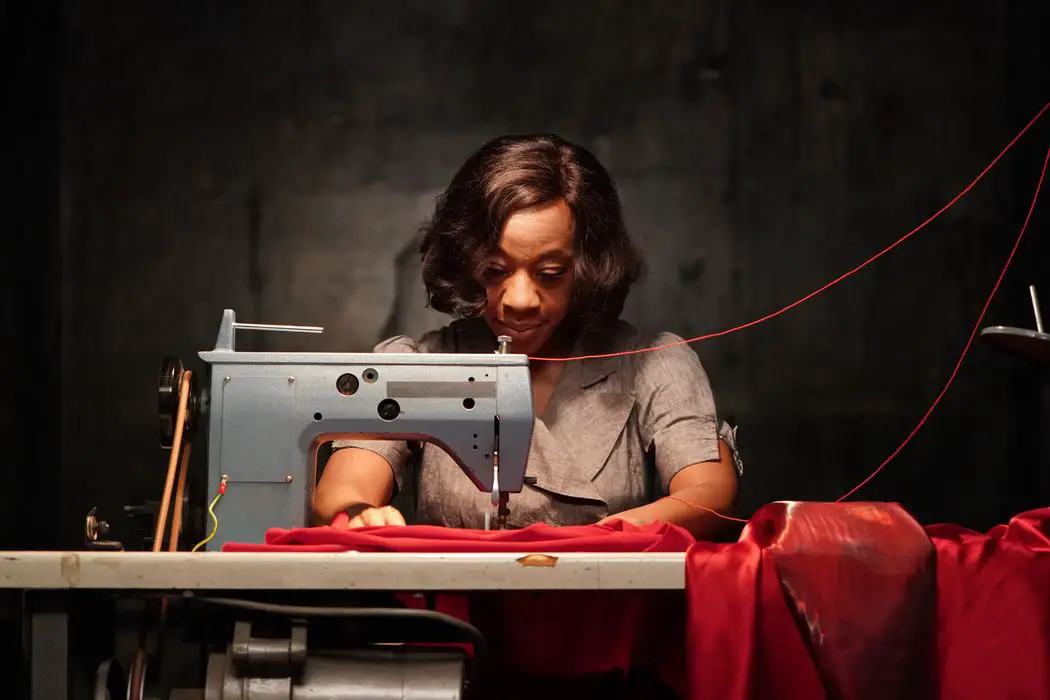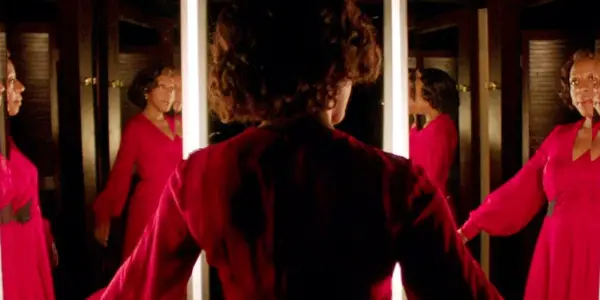IN FABRIC: The Devil Is A New Dress In Beautifully Sleazy Horror

A writer of fiction and criticism, and English student based…
One word that can hardly be applied to director Peter Strickland is “plain.” His films encompass a style that’s taking direct influence from the most colorful and outlandish of Italian cinema in the 1970s, including the works of Dario Argento and Mario Bava. In just a trio of directorial efforts, Strickland has taken on the images crafted by the aforementioned masters, using them as a vehicle to explore more perverse and timely matters that have the potential to rise above its inspirations.
His prior film The Duke of Burgundy, for example, dressed up a film about the dynamics of dominant/submissive relations in the erotic horror flair of Jess Franco. Before that was Berberian Sound Studio, the story of a sound designer losing his nerve while working on a Giallo film with a toxic work environment. In Fabric is his latest, and it appears that the erotica and horror come to a consensus with the addition of a wicked sense of humor. And the secret to it all is one size-36 dress that literally has the power to kill.
The Fashion Victims
Marianne Jean-Baptiste is Sheila, a recently divorced woman in London living with her difficult adult son (Jaygann Ayeh) who’s dating a strange witch-like woman (Gwendoline Christie) that Sheila can’t stand. Trying to get back into the dating scene, she decides to go to Dentley & Soper’s, a department store with equally witchy employees, including the verbose Miss Luckmore (Fatma Mohamed), to buy an outfit for the occasion. This leads her to the “artery red” dress, one worn by a store model who died shortly after posing for it.

As one expects from such an ominous backstory, mysterious events follow Sheila after wearing it. It starts with a strange rash, then a malfunctioning washing machine, then a dog attack that results in the dress being torn—before coming back intact. Meanwhile, the department store becomes home to odd rituals that range from the eerie whispers among the customers to late-night groping of mannequins while the elderly manager gets a sexual rush from it.
If that doesn’t sound strange enough, it’s only the first half. The second is concerned with a different set of central characters: washing machine repairman Reg Speaks (Leo Bill) and his fiancee Babs (Hayley Squires), who both also don the dress under different circumstances, and add to the further spiral of majestic insanity. As a result, it becomes a send-up to the anthology horror films from Hammer and Amicus Productions, the titans of British horror in the 70s.
Even without the comparisons to past figures in the genre, and the brazen flaunting of its influences, Strickland has crafted something that continues to differentiate him from the other flock of filmmakers turning to a retro aesthetic. The world of In Fabric is one populated by the most minute details of those older works, such as blatant ADR and stilted direction to compensate for a small set space, but there’s a comedic aspect that’s hard to find in the likes of The Vampire Lovers. It’s one that consists of Thatcher-era inside jokes among Brits, and takes an unabashed joy in all the grotesque events, the bulk of them involving Fatma Mohamed‘s performance delving deep into the most hammy kind of villainess by design. No awards will sadly be in the film’s future this season, but Mohamed ultimately holds the prize in one of the most unforgettable appearances on a screen, adding so much to the film’s mood with a simple glare and unique inflection.
Subtle Body Horror
What’s most fascinating about looking at Strickland‘s films is finding out what they may be saying or exploring on a larger scale. One can certainly read something about consumerism and the workplace in the film, what with its constant focus on employers browbeating their employees, who all happen to be the ones who wear the dress. The character Reg is even goaded into wearing it on a guy’s night out by his boss. One reading I see less acknowledged is the concept of the dress being a shared source of bodily contact with its wearers, a kind of anonymous intimacy you gain from the exchange of material possessions that could transfer their confidence, their fetishes, and even their fates.

The director himself even alluded to such with the Los Angeles Times, explaining how secondhand stores often provide clothes that still have the stains and odors of the past owner. “[It] can be very disorienting because you don’t know who had it before you,” he said. “You can’t picture them but you can smell them, which is the most intimate sense. It just activates the imagination.”
Within the dress’s collar is a stitched inscription in French that translates to “you who wear me will know me.” It’s evidence enough to the connection drawn between the characters through this single article of clothing, as they all become drawn by recurring motifs of appliances, sharing the same supervisors, and insecure love lives. Even if one pairing is engaged, they aren’t totally content, and it almost feels like a direct effect of the dress as an invading force that uproots their way of life into something nightmarish. Meanwhile, at that department store, the eccentricities go on, tightening the bond between customer and item through their own bizarre, fluid-exchanging methods.
In Fabric: Conclusion
Even writing this up does little justice for the unique experience In Fabric becomes. In all it takes in the tools of the trade present in cult classics, the addition of a more contemporary sense of transgression and a dazzling score by Cavern of Anti-Matter elevates it into something that can’t be dismissed as another dense attempt to recapture the glory days of stylish horror. Anyone disappointed in what the remake of Suspiria came out to be would be remiss to pass up this film. It’s every bit as fun in its production and scenario in an experience that will have you thinking twice about the next clothing display that catches your eye.
Have you seen In Fabric? Does the retro style benefit the film for you personally? What other modern films that emulate the Giallo era would you recommend?
In Fabric was released in the UK on June 28th by Curzon Artificial Eye, and in the US on December 6.
Does content like this matter to you?
Become a Member and support film journalism. Unlock access to all of Film Inquiry`s great articles. Join a community of like-minded readers who are passionate about cinema - get access to our private members Network, give back to independent filmmakers, and more.
A writer of fiction and criticism, and English student based in Baltimore. Berry’s aspirations of becoming an animator/filmmaker started young. It was a high school film studies course that shifted their interest to wanting to discuss them. They maintain a growing list of favorite films, ranging from Ingmar Bergman’s Persona to Stephen King’s Maximum Overdrive.













